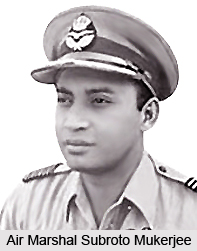 Air Marshal Subroto Mukerjee was born on 5th march 1911 in Kolkata.He belonged to a well to do Bengali family.His grandfather, Nibaran Chandra Mukherjee was a social and educational reformer of Bengal.His maternal grandfather ,Dr. P K Roy was the first Principal of Presidency College ,Calcutta and maternal grandmother Sarala Roy founded the Gokhale Memorial School.His uncle Indra Lal Roy was in Royal Flying Corps during the Second World War. Subroto Mukerjee received his early education from Diocesan School and Loreto Convent in Calcutta .In 1927 he passed his matriculation examination from Howrah Zila School.After that Subroto Mukerjee got admitted to Presidency College .Later he moved to England and studied at Cambridge University.From his childhood he had inclination for military service.
Air Marshal Subroto Mukerjee was born on 5th march 1911 in Kolkata.He belonged to a well to do Bengali family.His grandfather, Nibaran Chandra Mukherjee was a social and educational reformer of Bengal.His maternal grandfather ,Dr. P K Roy was the first Principal of Presidency College ,Calcutta and maternal grandmother Sarala Roy founded the Gokhale Memorial School.His uncle Indra Lal Roy was in Royal Flying Corps during the Second World War. Subroto Mukerjee received his early education from Diocesan School and Loreto Convent in Calcutta .In 1927 he passed his matriculation examination from Howrah Zila School.After that Subroto Mukerjee got admitted to Presidency College .Later he moved to England and studied at Cambridge University.From his childhood he had inclination for military service.
After completing formal education Subroto Mukerjee joined the first batch of Indian pilots at Royal Air Force College ,Cranwell in 1931 along with Bhupendra Singh and Amarjeet Singh. After two years training at Royal Air Force College he was commissioned into Royal Air Force on 8 October 1932. After a year he joined newly formed Indian Air Force as a pilot.In 1936 he was sent to noth west frontier province.Here he fought bravely against the militants and was awarded as the General Service Medal. For his exceptional courageousness he was Mentioned-in-Despatches in 1942.During the World War 2 he was the pilot of No.1 squadron of the Indian Air Force.He also commanded the No.1 squadron as a Squadron Leader of Indian Air Force. Air Marshal Subroto Mukerjee was the first Indian to command Flight, a Squadron, a Station (Kohat).For his distinguished service he was awarded as the Order of the British Empire in 1945.
After independence he assisted the Air Chiefs IAF.In 1952 he moved to England for attending a training at Imperial Defence College.After completing the training he returned to India and joined Indian Air Force on 1st April 1954, in the rank of Air Marshal.In 1954 he was promoted the rank of Chief of Air Staff of the Indian Air Force at the age of 43. Air Marshal Subroto Mukerjee was the first Indian to hold this rank.In 1960 he went to Japan as one of the first passengers of the inaugural flight of Indian Airlines. On 8th November 1960 Mukerjee died at the age of 49 in a restaurant in Tokyo when a piece of food blocked his windpipe.
Air chief Marshal Subroto Mukerjee was very efficient in personnel planing and development of Indian Air Force. Mukherjee had also a non-controversial and distinguished role as the Chief staff of Indian Air Force.




















